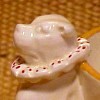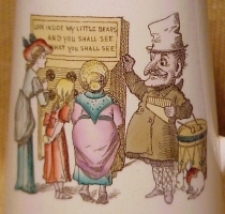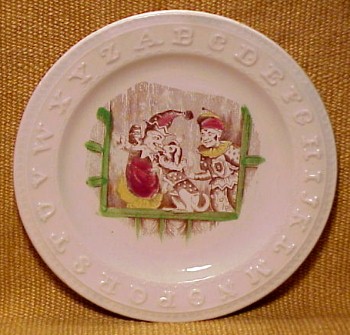Posted By: Mark
Posted on: 2011-06-25 19:44:38
Featured Item:
A Wedgwood Red Body Teapot
Dimensions: Height 4 in., Width 6 3/4 in.
Date: Late 1860's -- 1870's
Price: $450.00
 The Teapot Body
The Teapot Body When one attempts to classify a ceramic object, an obvious starting point is the "body," that is to say the clay itself. Is it porcelain or pottery, soft paste or bone china, earthenware or stoneware, dry body or glazed? Our little pot is an example of a dry body red stoneware. The term "dry" refers to wares which have received no additional glaze to seal or finish the exterior of the body. (In fact, the interior of this teapot is glazed to prevent the hot tea from being absorbed into the body.) This body classification is important because in the ceramic pecking order, porcelain was the body all others were measured against. Josiah Wedgwood challenged this maxim, however, demonstrating that other bodies could achieve the same degree of elegance.
The red stoneware dry body was developed by Josiah Wedgwood under the name "Rosso Antico." According to Robin Reilly's account,Wedgwood never wanted to produce a red body stoneware observing that it was a common product in the potteries. He felt that such a body could not help but be referred to as a common "red-Pot-Teapot." However upon his partner Bentley's urging, he relented perfecting a red stoneware body. This development resulted in a range of products marked by Wedgwood's high standards of design and sophistication. Still, he cared little for these wares and let production dwindle after Bentley's death in 1780.
 The Teapot Shape
The Teapot Shape What can we tell about our teapot from its shape? Wedgwood could have looked to two sources for this teapot shape, early 17th century oriental teapots and the 18th century English pots which were based on those earlier Asian pots.
When we look at teapots, we have to remember that teapots did not exist before tea-drinking became a western habit in the late seventeenth century. In the orient, boiling water was poured over tea leaves and allowed to steep in a little bowl prior to drinking. From this we derive the handless cups and saucers associated with eighteenth and early nineteenth century tea wares. The teapot is the result of western demand for a vessel in which to steep the tea prior to pouring.
 Wedgwood and the Red Body Teapot
Wedgwood and the Red Body Teapot Wedgwood in the 1860's was just beyond a crossroads. In 1842, Frank Wedgwood, grandson of Josiah Wedgwood I had found himself in control of a family company in serious trouble. Years of indifferent management on the part of the family had left the business with outdated facilities. A lack of capital led to the extraordinary decision to bring in outside partners and in 1844 to the more drastic decision to liquidate the holdings. The factory failed to meet its reserve, however enough capital had been generated to position Wedgwood for re-launch at the 1851 Exhibiton.
Batkin, Maureen; Wedgwood Ceramics 1846-1959: A new appraisal. London, Richard Dennis, 1982.
Reilly, Robin; Wedgwood, Volume I and II . London, Macmillan London Limited, 1989.
Posted By: Mark & Tim
Posted on: 2011-04-18 22:37:00
Featured Item:
The Wedgwood Punch Wares
Happy Birthday, Mr. Punch!
Among the many reasons to celebrate in the spring of the year, surely one of the most totally forgotten--at least in this country--is the birthday of Punch. This May he will turn a very sprightly 349. Wishing to do our part to bring the little fellow the attention he deserves, this month we are featuring some of Wedgwood's tributes to this favorite entertainer.
Seekers currently offers three examples of Wedgwood "Punch" wares, a creamer in majolica and two polychrome transfer-printed pieces in earthenware: a "Napier" shape jug and a rather extraordinary footed bowl. 
Majolica Creamer
Dimensions: Length 4 1/2 in., Height 3 in. (Handle)
Dates: Late 1870's, Early 1880's
Price: $875.00

/products/3083
Napier Jug
Dimensions: Height 6 7/8 in.
Dates: Late 1870's, Early 1880's
Price: $625.00
Footed Bowl
Photo/Specs
Dimensions: Width 4 3/4 in., Height 2 in., Diameter (Bowl) 3 7/8 in.
Dates: Late 1870's, Early 1880's
Price: $695.00
 The Punch Wares
The Punch Wares
Wedgwood's interest in the Punch tradition finds expression in two forms. First, majolica pieces that appear in Wedgwood catalog pages at least by 1876. Slightly later, judging by their 1878 design registration date, Wedgwood presented a series of transfer-decorated, ivory glazed utilitarian vessels, often appearing with colorful enamel highlights. Frankly, neither category receives much attention in the standard reference works.
One can find documentation of two Punch designs in majolica. Maureen Batkin's Wedgwood Ceramics 1846-1959: A New Appraisal, as well as majolica reference works by Karmason and Stacke and by Nicholas Dawes, illustrate a punch bowl appropriately studded by sculptural heads of Mr. Punch and supported by full figures of his dog Toby. In addition Dawes includes a teaset with Punch, Judy, and Toby fittings, from which our creamer derives. (Full citations below.)
Batkin, in her chapter on "Victorian Tablewares" makes quick business of the printed Punch wares, but illustrates some of the forms in the series (pg.124, pl.224 reproduced below.) She gives a short inventory of pieces; a rope handled jug known as the "Napier" shape, cruet, tea and beer sets. To this list of items, we can add a tall slender flagon with metal fitting and lid similar to the wine flagons found in jasperware.

Since these design motifs find their origins both in the traditional Punch and Judy puppet show and the popular nineteenth-century periodical named after our hero, a brief look at both sources seems in order.
 Background --The Punch and Judy Origins
Background --The Punch and Judy Origins
Mr. Punch is a creature of the theatre, a corruption of the Neapolitan comedia dell'arte figure Pulcinella. Originally he was a trickster who was constantly becoming entangled with other characters. While he always won in the end, at times he could be overbearing and his methods were often violent. He was accompanied by his wife, Joan (eventually anglicized to Judy). Samuel Pepys mentions seeing an Italian marionette show in Covent Garden on May 9, 1662, which is considered the forerunner of Mr. Punch -- and provides Punch aficionados a birthday date to celebrate.
Wedgwood's design motifs derive from the ongoing British tradition of the Punch and Judy puppet shows. These shows were originally seen as grown-up entertainments, but were transformed into children's amusements in the nineteenth century. The shows continue to this day with a basic central cast which includes Mr. Punch, his wife Judy, their baby, a hungry crocodile, Joey the clown, an officious policeman and a string of sausages. Toby the dog and Hector the horse, seen on Wedgwood's Punch transfers, were once regular characters, but now make only occasional appearances. There is even a third set of characters which now appear only in historical re-enactments.
For the Victorian, however, the name "Punch" suggested much more than a puppet show. Founded in 1841, the magazine Punch was conceived as a weekly periodical of humor and satire. While one naturally assumes that the paper was appropriately named for the puppet, the account contained on the website dedicated to the periodical's history tells a different story. The goal of the paper was to pair clever satiric wit with higher literary standards. One of the partners insisted that it should avoid the bitterness of similar current publications. In a clever turn of phrase, referring to the magazine's editor Mark Lemon, someone noted that it "should be like a good punch mixture -- nothing without lemon" -- at which point one of the founders proclaimed, "A capital idea! Let us call the paper Punch!"

The founders were well aware of the multiple connotations of the name. A Punch and Judy show was illustrated on the first cover and Mr. Punch was appropriated into the masthead of the magazine early on as a figure indicative of their goals. Generally viewed as reflecting public opinion, the magazine soon became a standard of the middle class and eventually permeated all levels of society. In line with the intent of the founders, Punch became known for its piercing, but polite observations of English life. This polite approach, harnessed with the ideal of high literary standards, made Punch acceptable for the British home, mixed company, respectable society, etc.
 Wedgwood and their "Punch" Series
Wedgwood and their "Punch" Series
While Wedgwood's two Punch series--the majolica wares and the transfer-printed wares --are loosely related, they approach the Punch tradition quite differently.
By the 1870's competition among English producers of brightly colored majolica wares was fierce; the basis of that competition was novelty of design; and the pressure for new sources of inspiration was great. Wedgwood's majolica wares use the cast members of the puppet show as three-dimensional ornaments for their vessels--handles formed from Punch's head and hat, Judy's face at the base of a spout, full figures of Toby as support "feet." Wedgwood may have been motivated by the famous "Punch" bowl (supported by a full figure of the clown) produced by their competitor George Jones which seems to have slightly preceded Wedgwood's offerings on the market. In any case, the puppet motifs are employed purely for decorative effect with no added satirical intent.
 l
l
Wedgwood Majolica Punch Bowl George Jones Majolica Punch Bowl
With the printed wares, however, the Punch images are unmistakingly viewed through the filter of the magazine. Even if the similarity in graphic style was not great enough to establish the link, the transfers include written labels that indicate that these are comic images that carry a message. While references do not establish whether Wedgwood's drawings were taken directly from the magazine or more generally inspired by its spirit, we do know that the pottery directly used material that had appeared in Punch for another pattern (John Leech's amusing "Fishing" series). Whatever the case, Mr. Punch appears on the Wedgwood wares in a guise wholly congruent to his role in the magazine: the champion of common sense doing battle, however tongue in cheek, with the follies of society. This additional content makes the transfer wares a rich subject for consideration.
Note. While the sculptural details of many of the transfer printed pieces, like our Toby-footed bowl, or the Punch cruet stopper illustrated by Batkin, seem perfectly adapted to a majolica glaze treatment, we have never never seen any such examples. Nor have we seen majolica shapes like our creamer with a printed decoration. The full relationship of these wares is still to be explored.
 The Punch Transfers
The Punch Transfers
While the number of different Punch transfers is not great, together they create a coherent picture of Mr. Punch as a crusader against foolishness. We have identified four different tableaus, as well as two simpler secondary images.


In the first scene, Punch, with a grand flourish, ladles from a large punch bowl labeled "The Very Best Physic." The recipients of his largesse are four men identified by their costumes as representatives of the far reaches of the world. What exactly is the "best physic? The cup of worldwide brotherhood? Or perhaps--remembering what punch represented to the magazine founders--a good dose of satire? This transfer is frequently accompanied by the first of the simpler images: the dog Toby, Punch's constant accessory, with serving tray and hot water.
Our second scene presents Punch as a sideshow huckster luring an unsuspecting crowd to a peepshow contraption with the sign "Look inside my little dears and you shall see what you shall see." We can be confident that the crowd will not be satisfied and that what is really on display here is the gullibility of the public.




Two additional vignettes present our friend in his most heroic, or at least pugnacious, guise. In the first he has entered the boxing ring. His hat set aside, he strips down to fighting garb ready to take on his foe. In the other, Punch appears at full tilt--whip and book in hand--violently chastising a clownish figure labeled "Cant and Folly" and a disreputable looking lout in uniform labeled "Official Misrule." In both scenes he is assisted by a most excited looking Toby.
Finally we have one more single image, most often seen on the reverse of objects: Punch victorious. He is mounted on Hector the horse and garbed in heroic (or merely imperial?) classical togs. Appropriately, closer examination reveals that Hector is really a jointed hobby horse. Mr. Punch raises his hand in triumph or maybe only to wave farewell.
 Why Punch?
Why Punch?
Was Wedgwood making a social or political statement with these satirical designs? What seems to have been their intent? Thumbing through Batkin's chapter on Victorian tablewares may give us a clue.
Perusing the wide variety of printed designs employed by Wedgwood in the last decades of the nineteenth century, one is struck by how frequently the pottery sought its inspiration in the currents of what we call "pop culture" today. Patterns reflect the decorating trends current at the time from the mania for the Japanese to the revival of Adam style neoclassicism. Departing farther from the design arts, we see series based on boating, hunting and the perils of fishing. Literary subjects range from the children's story "Little Red Riding Hood" to the popular Scott novel Ivanhoe. Scenes of country life and children's play appear, and even patterns based on food preparation and farmyard poultry. What we can observe is that the decorative content of tablewares was increasingly important relative to mere function. We can also see that Wedgwood was engaging in some fairly aggressive and clever marketing to consumers with specific and varied interests.
So are we too far out of line if we compare Mr. Punch's appearance on Wedgwood wares to the images of Superman or Batman, lifted from the pages of twentieth century comics, to appear on the "Happy Meal" cups and packaging of fast food chains? After all, though he lacked the cap or cowl, our friend Punch was quite the popular crusader in his own way.
 Conclusion--Collecting Today.
Conclusion--Collecting Today.
We have encountered three sorts of collectors who are interested in the Punch wares. There are those who are simply charmed by the decorative quality of the majolica or printed wares, and there are those who collect Punch and Judy items from other makers and in a variety of media. (See ABC plate below.) Certainly we cannot overlook the omnivorous Wedgwood collectors seeking wide representation of the pottery's vast output (and perhaps no other pottery has inspired so many such passionate devotees.)
In addition, we would like to suggest these wares to those interested in the rich tradition of British satire. What better way is there to add a three dimensional element to collections of prints and books. British satirists were unequalled at pointing out the pitfalls, blemishes and buffoonery of social life, the people, the crown and the government; in the forefront stand the writers and artists of Punch. In many ways they speak to us clearly today, afterall, the magazine did not say its final farewell until 2002.
Later, Mark & Tim

Sources
We acknowledge once again what we find to be an indispensible resource:
Batkin, Maureen; Wedgwood Ceramics 1846-1959: A new appraisal. London, Richard Dennis, 1982.
Sources on majolica cited:
Dawes, Nicholas M. Majolica. New York, Crown, 1990.
Karmason, Marilyn G. and Stacke, Joan B. Majolica: A Complete History and Illustrated Survey. New York, Abrams, 1989.
For the history of the magazine Punch we are indebted to its official website.
http://www.punch.co.uk
Punch cover and images of majolica other than the featured item are from Google Images.
« Prev
Next »





















 /products/3135
/products/3135

